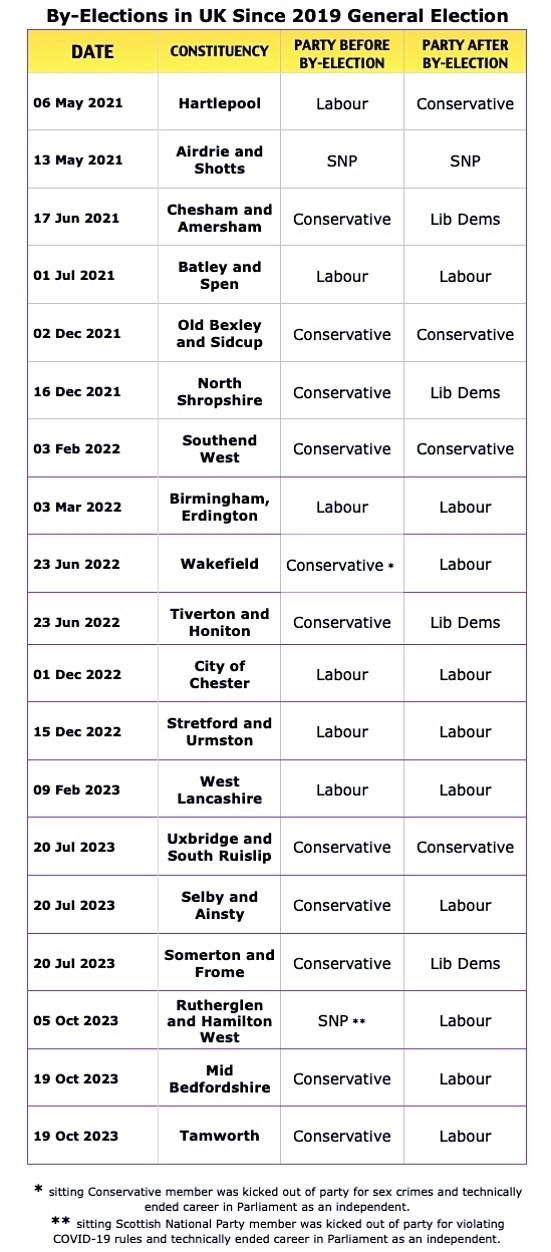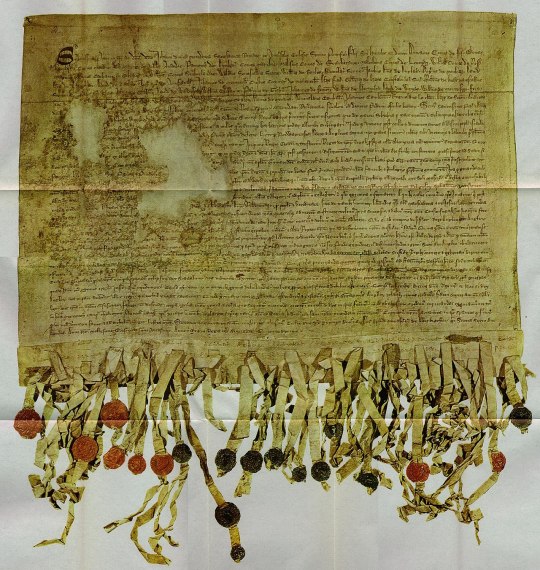#mid bedfordshire
Text
youtube
In the UK, political analysts and journalists have been searching the thesaurus to find synonyms for disaster to describe what happened to the Conservative Party in two by-elections on Thursday.
The by-election results only confirm that the Tories are on a downward spiral.
Peter Walker at The Guardian spells out the implications.
But even though Tory aides will point to the murky circumstances in which the incumbents in both Tamworth and Mid Bedfordshire, Chris Pincher and Nadine Dorries, departed their seats, Labour’s success will send a chill through the spines of Conservative MPs for several reasons.
The first is the sheer scale of the losses. The byelection record tables for swings and biggest majorities overturned are becoming increasingly filled with votes that took place since 2019, and there is now another one to be added.
Dorries’ 24,664 Conservative majority was the biggest numerically to be lost in a byelection at least since 1945, potentially ever, as Labour’s Alistair Strathern won a majority of 1,192.
While Tamworth involved a slightly smaller majority, the swing to Labour’s second new MP, Sarah Edwards, of 23.9 percentage points to her party from the Tories, was even greater than the 23.7 percentage point swing in July’s Selby and Ainsty byelection.
The second reason for Labour joy and Conservative jitters is the way that Labour pushed their way to a win in Mid Bedfordshire despite a full-on parallel effort from the fearsome Liberal Democrat byelection machine, one which has delivered four massive wins since 2021.
The Lib Dems had insisted that in the mainly rural seat only they could tempt enough Conservative votes to switch to them. In the end, their vote tally rose, but even they were steamrollered by a Labour machine clearly motivated by the prospect of government.
The Mid Beds result also carries another bad omen for Sunak and his party: the way that English voters are becoming increasingly good at deciding who they need to club together tactically to unseat the Conservatives.
Increasing numbers of people are voting tactically in these by-elections to specifically defeat Conservative candidates. They may not agree with everything that Labour or the Lib Dems may stand for, but the main point is to remove the Conservatives from power.
Tamworth is was statistically the 57th safest Tory seat in the UK out of the 350+ which the Conservatives hold. It doesn't necessarily mean that Labour and the Lib Dems would pick up almost 300 seats. But in the next general election, which must be held no later than 28 January 2025, the Conservative Party will have to defend many seats which they've been taking for granted.
One fun aspect of the October 19th by-elections is that the unsuccessful Conservative candidates bolted out of the buildings as soon as the results were made known. It doesn't violate any rules, though it's poor election night etiquette.

They probably had some idea where things were headed and wanted to avoid answering questions about the WAY bad night for their party.
To see the extent of the collapse of the Conservative vote, check out the results on a graph.

If you're wondering why the BBC doesn't list every single candidate on those graphics, check out the entire list for Mid Bedfordshire which includes one named Prince Ankit Love Emperor of India.
Here's a list of how parties fared in the 19 by-elections since the general election of 2019. The Conservatives have won just 1 of the 12 in the past 20 months; and that was a narrow victory to retain Boris Johnson's seat for Uxbridge and South Ruislip. More important than the number of Tory losses is their geography – constituencies lost to Labour and the Lib Dems in traditionally Conservative areas.

#uk#house of commons#uk elections#by-elections#tamworth#mid bedfordshire#labour#lib dems#conservative party#scottish national party#sarah edwards#alistair strathern#keir starmer#winter is coming for the tories
2 notes
·
View notes
Text

Newnham Avenue, Bedford, Bedfordshire, England
Mid 1960s
2 notes
·
View notes
Text
Tory Blues
Any government which loses two safe seats after its Prime Minister has just “relaunched” himself with less than 12 months to go before a General Election simply cannot retain power. The swing from Conservative to Labour in Tamworth, at just shy of 24%, in line with the previous record-beater at Selby and Ainsty, is phenomenal and doubles the swing implied by Labour’s allegedly “fragile” opinion poll lead (perhaps commentators will stop describing it like that now). The loss of Mid Bedfordshire is even more depressing for Tory electoral strategists - Conservative since 1931, the seat epitomises the Tory-voting shires and unlike Tamworth, which returned a Labour MP between 1997 and 2010, it has no history of representation by any other party. There will be furious argument about whether the strong Liberal Democrat campaign in Mid Beds helped or hindered the Labour challenge, and the significance of “stay at home” Tory abstentions to the result, but the very fact a seat like Nadine Dorries’ old stomping ground now has a “red” MP tells you all you need to know about Tory prospects at the next General Election.
These two extraordinary by election results at this stage in the electoral cycle means there is barely a Conservative seat anywhere in the country that can now be considered truly safe, that Labour’s onward march to power must now be considered unstoppable and that a landslide at the General Election is looking increasingly likely.
20th October 2019
#british politics#Tamworth by election#mid Bedfordshire by election#Tories in crisis#next uk general election#conservative government#Labour’s march to power
2 notes
·
View notes
Text
Labour overturn huge Tory majorities to seize Tamworth and Mid Bedfordshire seats | In Trend Today
Labour overturn huge Tory majorities to seize Tamworth and Mid Bedfordshire seats
Read Full Text
or
Full Article on MAG NEWS

View On WordPress
#Celebrities#Labour overturn huge Tory majorities to seize Tamworth and Mid Bedfordshire seats#Money#Motors#Politics#ShowBiz#Sport#Tech#Trends#UK#US#World
0 notes
Text
Labour overturn huge Tory majorities to seize Tamworth and Mid Bedfordshire seats | In Trend Today
Labour overturn huge Tory majorities to seize Tamworth and Mid Bedfordshire seats
Read Full Text
or
Full Article on MAG NEWS

View On WordPress
#Celebrities#Labour overturn huge Tory majorities to seize Tamworth and Mid Bedfordshire seats#Money#Motors#Politics#ShowBiz#Sport#Tech#UK#US#World
0 notes
Text

(BL Egerton MS 2781; The "Neville of Hornby Hours"; 14th c. f.76v)
Today (Nov. 30th) is Andermas, the feast day of Saint Andrew: apostle, martyr, and patron saint of Scotland (amongst many other patronages). Traditionally, Saint Andrew's Day marks the beginning of Advent (starting the Sunday closest to November 30th) in both the Eastern and Western Christian liturgical calendar.
Saint Andrew has been the patron saint of Scotland for some 700 years, beginning in 1320 with the Declaration of Arbroath addressed to Pope John XXII. Written and sealed by fifty-one Scottish barons and magnates in the reign of King Robert I - popularly known as 'the Bruce' - (r.1306-1329) the Declaration was part of a broader diplomatic effort to assert Scotland's position as an independent kingdom during the First War of Scottish Independence (1296-1328) in spite of the Pope's recognising of King Edward I of England's claim to overlordship of Scotland in 1305 and his excommunication of Robert from the Church in 1306.

(National Records of Scotland; The Declaration of Arbroath [Online], URL: https://www.nrscotland.gov.uk/Declaration)
Elsewhere in the United Kingdom, such as in Bedfordshire, Buckinghamshire, Hertfordshire and Northamptonshire, 'Tandrew' or 'Tandry' - as St. Andrew's Day was colloquially known - was traditionally once a major festival in many rural villages. Thomas Sternberg, describing popular customs in mid-19th-century Northamptonshire writes that "the day is one of unbridled license [...] drinking and feasting prevail to a notorious extent. Towards evening the villagers walk about and masquerade, the women wearing men's dress and the men wearing female attire, visiting one another's cottages and drinking hot elderberry wine, the chief beverage of the season." (Sternberg, 1851: pp.183-85).
--
As the nights grow longer, Christmas steadily begins to come into our view, be sure to think upon this old folk-rhyme on this chilly night.

(Northfall, G.F. (1892), "English Folk Rhymes: A collection of traditional verses relating to places and persons, customs, superstitions, etc.", (London: Kegan Paul, Trench, Trübner & Co. Ltd.), p.455)
#middle ages#14th century#scotland#saint andrew#illuminated manuscript#manuscript#robert the bruce#paleography
8 notes
·
View notes
Text

The Reform candidate for the Mid-Bedfordshire by-election yesterday looks like he’s about to headbutt you outside a pub while his goth “biker mama” watches. (Labour won – phew!). Is it wrong that I do love his powder blue suit? (I would wear it with a ruffled shirt).
#british politics#midbedfordshire byelection#reform party#thug#goth chick#biker mama#powder blue suit
12 notes
·
View notes
Text
Greg Hands claiming the Labour vote went down in Mid Bedfordshire



4 notes
·
View notes
Text
The existence of Mid Bedfordshire implies that there is also at least a Cringe Bedfordshire and possibly even a Based one.
3 notes
·
View notes
Text

We can do so much better
The elephants in the room with Rishi Sunak - cartoon - Reasons for the Mid-Bedfordshire and Tamworth byelection losses seem to be a mystery to the prime minister - The Observer
#corruption #prejudice #pollution #enviroment #cleanrivers #cleanseas #greensolutions #humanity #inequality #racism #values #imaginebetter #movingforward
2 notes
·
View notes
Text
UK Labour Party wins by-election in two seats
British Prime Minister Rishi Sunak’s ruling Conservative Party was defeated in two by-elections on Friday, with Alistair Strathern and Sarah Edwards winning in Mid-Bedfordshire and Tamworth respectively.
By-election results indicate that voter support in Tamworth, central England, and Mid Bedfordshire, north of London, has shifted from the Conservatives to Labour.
Keir Starmer, leader of the opposing Labour Party, claimed his party would be able to compete and win seats in parts of the country where the opposition had never won before.
History is in the making.
Read more HERE

#world news#world politics#news#europe#european news#uk news#uk#uk politics#labour#labour party#rishi sunak#sunak
2 notes
·
View notes
Text
I'll be interested to see what happens with Thursday's by-elections. Apparently the Tories are privately confident they'll keep both seats, and say that losing one would be sign of 'the worst case scenario' for them. Bookies are saying it's likely Labour will win both (although their odds for Mid-Bedfordshire only give Labour a slight edge over the Tories), and polling currently has them neck-and-neck in Mid-Bedfordshire, and Labour slightly in the lead for Tamworth.
So, it'll be intriguing to see what the actual result is, and what the fallout will be. If Labour win both, it might push the Tories into trying to oust Sunak, but it feels like if they manage to hold on to one or both, he'll probably be safe until the general election (at least so long as there aren't a bunch of other by-elections).
2 notes
·
View notes
Text


Ravensden, Bedfordshire, England
Mid 2010s
0 notes
Text
The King’s Orphan and the Latimers
“The king started to distribute Lucy’s lands on 27 June 1285. As rewards for service on the recent campaign in Wales, he granted £100 a year from Danby to Robert FitzWalter; custody of Brotton, Skinningrove, Yarm and the remainder of Danby to William Latimer; and custody of Kirkburn to William de Leyburn. On 15 October 1285, custody of Bozeat was granted to the king’s yeoman, Roger de Fricourt. These were temporary rewards that would last only as long as Lucy was a minor.
The more important question was who would benefit from her lands more permanently through her marriage. This was granted on 17 December 1285 to Pierre de Estaveyer, alias Peter de Stanye. He was a Savoyard and a nephew of the king’s great friend Otto de Grandison. Stanye was a king’s yeoman in October 1283 but rose to become a royal household knight between 1284 and 1286, and by 1290 he was a member of the queen’s household. In this year, Otto granted him part of his Irish lands and he obtained a protection to go to the Holy Land with Otto.
He is not heard of in England again and by 1303 he was living overseas and nominated attorneys to act for him in England and Ireland. Peter did not marry Lucy himself and transferred her marriage, in unknown circumstances and at an unknown date, to his household colleague, William Latimer. The Latimers were not quite a ‘new family’ but had recently risen to prominence.
The principal Latimer property was the manor of Scampston (Yorks E.R.), which they had held since the mid-twelfth century, and by 1202 they were also holding the manor of Terrington, but the first important member of the family was William (d.1268) who was active during the 1250s and 1260s and rose to prominence in the service of Henry III. His son William II (d.1304) and grandson William III (d.1327) followed in his footsteps, with William II serving Henry’s son Edward I, and William III serving Edward I and his son Edward II.
It was a common pattern for generation to follow generation in royal service and it created ‘curialist’ families. William I served as sheriff of Yorkshire between July 1254 and May 1260, and also as escheator north of the Trent from November 1258. By 1260 he was one of the king’s knights and in October 1263 he was appointed, with another, to negotiate in the king’s name with Louis IX of France, being present when Louis made his ‘award’, the Mise of Amiens, on 23 January 1264. He was reappointed as sheriff of Yorkshire in May 1266, but his son, William II, acted as his deputy at the Michaelmas 1267 audit, and he died in November 1268.
He had enlarged the patrimony and provided for a younger son by acquiring the marriages of the sisters Alice and Christine, heirs of the Ledet inheritance in Northamptonshire, Leicestershire and Bedfordshire, who were married to his sons, William II and John. Much of the estate was still held by the girls’ great-grandmother, Christine Ledet, who died some time between 1266 and 1270, and another portion by their mother Ermentrude, widow of Walter Ledet (d.1256), who died between 1282 and 1292.
Ermentrude had her dower third and also had custody of the rest of her late husband’s lands during the minority of her daughters. William II was married to the elder daughter, Alice, by June 1268, when she was of full age, and he had seized some or all of the lands. Ermentrude forced him to restore the lands to her and pay her a fine of twenty-five marks before she would make over to him formally the lands that would make up Alice’s portion.
On 8 November 1268 an order was given to provide a valuation of the lands in Northamptonshire so that Alice and William could have livery. William II Latimer was distinguished as ‘a long-serving and talented household knight’ of Edward I. In May 1271 he was preparing to join Edward on crusade and he was a member of Edward’s royal household throughout his reign, as a knight in 1278 and 1279, and as a banneret from 1284 until his death in 1304.
It was because of his services on the Welsh campaign of 1282–83, during which he had a lucky escape from drowning at the Menai Straits, that he was granted custody of part of Lucy’s lands in 1285, and this may have prompted him to acquire Lucy’s marriage from Stanye. She may have been transferred in 1290, when Stanye was preparing to leave the country and she was eleven, but this was certainly done by 9 November 1293 and, by 19 August 1294, if not sooner, Lucy was married to Latimer’s eldest son, William III.
According to an enquiry held in July 1328, they were married by words of present consent, and this was later ‘solemnised’ in church. There is no evidence of Lucy’s whereabouts from the time of her birth at Kilton in 1279 until 1294, but it can be assumed that, after the death of her grandfather, she was kept securely in the custody of Stanye and then the Latimers. Lucy reached her fourteenth birthday in March 1293 and her husband was then entitled to take possession of her inheritance, but the Latimers again failed to observe the formalities and tried to take possession of the lands they did not already hold before proving her age.
These were the manors of Bozeat, still held by Roger de Fricourt, and the more valuable Kirkburn, custody of which William de Leyburn had given to Walter de Rokesley. The writ for Lucy’s proof of age was not sued out until 28 October 1294 and the return eventually included a woeful tale by Rokesley’s attorney, Walter de Throcking. According to this, control of Kirkburn had been wrested from Rokesley on 9 November 1293 by Lucy, Thomas Latimer and others.
On 16 February it was restored to Rokesley, but on 22 February, presumably at the Latimers’ instigation, the escheator was ordered to go to Kirkburn and Bozeat to investigate reports that the custodians had been committing waste. Rokesley was again ousted on 19 August (1294) by Lucy and William Latimer, now identified as being married, and others. He was restored on 6 October but ejected again on the following day.
The Latimers obtained their writ on 28 October but Rokesley was restored on 11 November. On 3 December, he was ejected again by men from Kirkburn and Scampston, acting on behalf of William and Lucy, who had broken the doors of the hall and grange, taken Rokesley’s corn and goods, and beaten and ill-treated Throcking. An inquisition for the proof of age was not taken until 7 January 1295 but this proved to be inadequate.
It did not specify Lucy’s age, nor that Leyburn and Rokesley had been warned to be present, saying only that Latimer had sent his bailiff in his place but Leyburn and Rokesley had not come because they did not hold any of Lucy’s lands in the county. Two weeks later, on 22 January, another writ was issued and another inquisition was held on 17 March at Kirkburn. This time it was attended by Throcking, who gave an angry and detailed account of how he and Rokesley had been treated by the Latimers.
According to this, Lucy had been present during the ejections, but it is likely that she was there simply in a passive role as the person in whose name title was being claimed. Equally, it was because the lands were her inheritance that Throcking concluded by saying that she should not be allowed to have possession of them until she had been punished for her contempt of the king in her repeated violations of the orders for Rokesley to have possession, and had compensated Rokesley for his losses.
On 20 April 1295, when Lucy was already sixteen, William and Lucy officially and formally took possession of her lands. William was at that time in Wales in the midst of the campaign against the Welsh revolt and he did fealty to the king while they were both at Llanfaes on Anglesey. On the same day, William promised in the presence of the king himself that, within forty days of leaving Wales from the king’s service, he would compensate Rokesley for having ejected him from Kirkburn without having proved Lucy’s age.
Lucy and Latimer’s marriage had begun in disturbed circumstances. It is curious that the same problem should have occurred in succeeding generations but it would be facile to assume that a disregard for legal niceties was a family failing, or that such an attitude, if it existed, might be symptomatic of a wider attitude that would affect their marriage. There is next to nothing to indicate the nature of the marriage between Lucy and Latimer, which lasted until 1303.
She occurs once directly and once indirectly during this period. The direct reference comes from early 1302 when she and Latimer confirmed a grant made by a burgess of Yarm to the Dominican Friars there at what was evidently a gathering of local notables. Both the grant and the confirmation were witnessed by Nicholas Lord Meinill, his kinsman Sir John de Meinill of Middleton, Sir Arnold de Percy of Kildale, Sir Robert Gower and various others.
The other reference, equally conventional, was the birth of a son to them, another William. The date of his birth is unknown, the only evidence being the statements in his father’s inquisition post mortem that he was aged twenty-five or twenty-six in March 1327. While the ages given in the inquisitions are known to be unreliable, they become more so the younger the heir, so it is possible that these were reasonably accurate and that the boy was born in 1300 or 1301, or a year or so either side.
There is no evidence that any other children were born and, while this does not necessarily mean that there were none, circumstantial evidence suggests that none survived to adulthood. There is inevitably a great deal more information about Latimer’s activities during this period. Possession of Lucy’s lands gave him a landed position of consequence, entirely independent of his father who lived until 1304.
He was knighted by the king in 1294–95, probably while he was serving in Wales. Later in 1295 he was summoned to serve in Gascony and in October obtained a protection. He received the usual military summonses from 1297 onwards, in February 1299 he received his first individual summons to parliament, and in 1300 he was a banneret of the royal household like his father.
Both Latimers were among the twenty-one knights who represented Yorkshire in January 1300, the father representing the East Riding and the son the North Riding, and the younger William invested further in the North Riding by acquiring the manor of Sinnington, at some date between 1300 and 1303. This was later held jointly with Lucy, and his acquisition was enhanced on 12 December 1303 when he was granted free warren and a market and fair there.
He was serving in Scotland with the king in May 1298, obtained a protection in November 1299 when planning to go again with the king, and in the autumn of 1300 was serving in the Berwick garrison led by his father. He was setting out again in June 1301, and he received wages as a banneret, and for another knight and six esquires with him for the period 20 July to 22 September.
In early 1302 he was evidently in Yorkshire when he and Lucy confirmed the grant to the friars of Yarm, but he was back in Scotland by September 1302 when he was instructed to stay where he was, despite the recent summons to attend parliament. In October, he obtained a protection because he was staying in Scotland, although at the end of November he led a murderous attack on Nicholas Lord Meinill’s manor and chase at Ingleby Greenhow.
A constant stream of letters of protection and of respite of debts suggests that he remained in Scotland between June 1303 and the summer of 1304 during the long over-winter campaign. He was almost certainly with the king at Dunfermline on 12 December 1303, and he may also have been there on 12 February 1304. Before leaving for this campaign he had left Lucy to reside at Kirkburn.
While little is known of their marital life together, for Lucy, at least, the marriage had become intolerable and she had decided it should be terminated. On Monday 16 December 1303 she fled from Kirkburn, and by 22 September 1304 she had begun a suit at the court of Archbishop Thomas Corbridge for her marriage to be annulled. There is no surviving direct record of the case but, according to later references, the grounds were consanguinity, but it was established that neither had known of the impediment when they were married so their son remained legitimate.”
- Bridget Wells-Furby, Aristocratic Marriage, Adultery and Divorce in the Fourteenth Century: The Life of Lucy de Thweng (1279-1347)
3 notes
·
View notes
Text
Arus Perubahan di Inggris Kuasai Pemilu Sela, Anies-Gus Muhaimin Miliki Peluang Lebih Besar untuk Menang di Pilpres 2024
JAKARTA | KBA-Tuntutan atas keadilan sosial dan pembangunan yang inklusif bergema dalam pemilu sela (by-elections) di Mid Bedfordshire, Inggris. Arus perubahan dan keadilan sosial ini membuat Partai Buruh berhasil menginspirasi pemilih di Mid Bedfordshire dan Tamworth dan memenangi dua pemilu sela berturut-turut di sana dari partai berkuasa Konservatif di bawah Perdana Menteri Inggris Rishi…

View On WordPress
0 notes
Link
The defeated Conservative says people "respected my track record" and "knew who I was".
0 notes